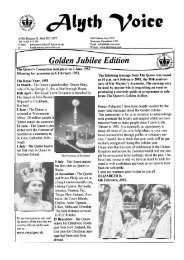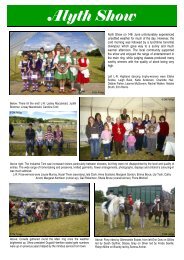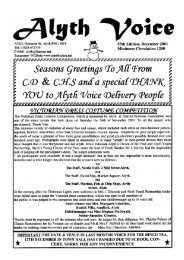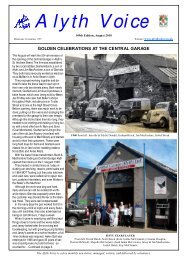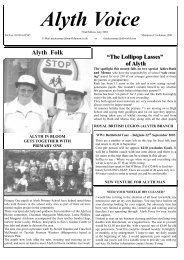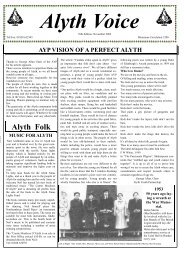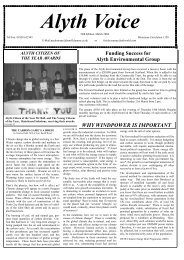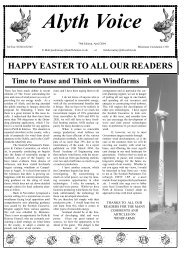June - Alyth Voice
June - Alyth Voice
June - Alyth Voice
Create successful ePaper yourself
Turn your PDF publications into a flip-book with our unique Google optimized e-Paper software.
Following our research into this local volunteer regiment, this month we continue<br />
with an extract from “A Narrative of the Royal Scottish Volunteer Review<br />
in Holyrood Park on the Seventh of August 1860” by Ernest Ralph Vernon,<br />
describing the very first Holyrood Volunteers Review.<br />
© Print of Royal Scottish Volunteers Review - Holyrood 7 August 1860 by Schenk & McFarlane<br />
“THE REVIEW<br />
The Review bands, being those of the 13th Light Dragoons, the 78th Highlanders,<br />
the 29th Regiment, and the West York Rifle Militia, advanced from the line,<br />
and took up a position opposite to the Royal flagstaff, leaving sufficient space<br />
for the Volunteers to pass the Royal carriage. Here also the General Commanding<br />
in Chief and his staff took their stand. On a given signal the whole army was<br />
put in motion, and the marching past commenced.<br />
The general effect was very striking, as brigade after brigade got into motion.<br />
There was not the gorgeous blaze of scarlet and gold which gives so dazzling<br />
an effect to a review of our regular troops, but the quietness of colour generally<br />
pervading the mass had a novel and pleasing appearance, and led one irresistibly<br />
to the thought that, as the movement was so evidently not got up for show,<br />
its continued efficiency and its permanence were the more to be looked for.<br />
To attempt anything like a description of the uniforms worn by the different<br />
corps, would be about as easy as to arrange the colours in a Berlin-wool basket<br />
after a couple of kittens had taken an afternoon’s amusement of the contents.<br />
Suffice it to say, that from the bright scarlet of the Cavalry and Engineers down<br />
to the palest of grays of the Dumfries Rifles, there was every shade of colour<br />
and colourlessness that can be conceived. Among the Artillery, as might be<br />
expected, blue was the favourite hue; while the Rifles, beginning with the dusky<br />
gray of the City of Edinburgh, - which, with its polished belts, gives to a column<br />
when seen from a distance, the look of a stack of the Earl of Zetland’s best<br />
Jewels, - wandered through every variety of gray mixture, with here and there a<br />
patch of green, and an occasional bright facing or stripe, which least gave a<br />
pleasing floral effect to some of the columns.<br />
To reach the spot for wheeling into the saluting base, as that line of march is<br />
called in which the saluting point is situated, each column had to pass behind a<br />
rising ground which hid it from the view of the Grand Stand and the other Volunteers;<br />
and when it emerged, it was marching at wheeling distance—that is, each<br />
company was following the other at a distance equal to its own length. Like<br />
masses of ore passed into the bowels of some vast machine, and reappearing<br />
in solid compact bars, so column after column was lost to view, to reappear in<br />
steadily-moving straight lines of companies, which marched along the saluting<br />
base with a regularity of step that, in most cases, could not be surpassed.<br />
Placed at certain points on the line of march were pioneers of the 78th Highlanders,<br />
and close to these it was the duty of each officer commanding a company,<br />
to pass—a very wise substitute for the usual flags, which are so easily<br />
avoided, and are generally knocked down by the first company that reaches<br />
them, “covering” being proverbially the weak point of Volunteer officers. Not one<br />
inch, however, will Pioneer Pipeclay be induced to budge for all the Volunteer<br />
captains in Great Britain. Not even when Her Majesty’s escort, in taking up its<br />
position, makes a show of riding him over, does he move a muscle. So firm<br />
does he stand, that the rasp of the hilt of Captain Dressup’s sword against his<br />
sporran is heard by the ladies in the Grand Stand, who, by the by, allege that<br />
though otherwise totally motionless, Pioneer Pipeclay, like “pallida mors,” kept<br />
making time—”equo pede” - with his heels to the music of the Review band.<br />
These are not the first volunteers to be seen. He is one of the heroes of Lucklow.<br />
Does he give his adherence to the views of our Peels and Robertson Gladstones<br />
or not? One would like to have a crack (Scotticé) with him over a good<br />
foaming pot, and have his views on things in general, and the Volunteer movement<br />
in particular.<br />
Her Majesty watched the various corps as they flowed by unceasingly with<br />
great apparent delight. She seemed in high spirits, and smiled and bowed to the<br />
corps as they passed with more than Royal condescension. The Prince-Consort<br />
seemed also to take a very lively interest in the scene, scrutinising the companies,<br />
and nodding his approval to the Duke of Buccleuch, with whom he<br />
9 TH PERTHSHIRE (ALYTH) VOLUNTEERS<br />
24<br />
conversed during the greater part of the Review. The Princesses too, seemed<br />
to enjoy the whole scene, as did also the Duchess of Kent, who, we are sorry to<br />
say, looked far from well. What the brilliant staff of officers, many of them heroes<br />
of world-wide renown, thought of the display we cannot say, but doubtless,<br />
with the usual generosity of their cloth, their criticisms would be lenient and their<br />
words encouraging. The people in the Grand Stand could not restrain their<br />
enthusiasm. Even the near neighbourhood of Royalty failed to prevent sundry<br />
bursts of applause, as an unusually good marching company passed by. All the<br />
Highland corps were favoured with special marks of approbation, as indeed<br />
they are on every occasion.<br />
In all, 348 companies marched past Her Majesty; and, as each company<br />
consisted of sixty men - besides officers and sergeants - the grand total cannot<br />
have been anything under 22,000 men. Of these, from 1800 to 2000 were Volunteers<br />
from the North of England, thus leaving about 20,000 as the total number<br />
of Scotch Volunteers who took part in the Review. Such a result cannot fail<br />
to be gratifying to every Scotchman, and has been cheerfully acknowledged by<br />
all the English press as most creditably to the zeal and energy of Scotland. That<br />
Scotland, with so few resources, and so limited a population, should be able to<br />
bring together so powerful a body of men - surpassing considerably in numbers<br />
that brought together by the wealthier and more populous sister country—is a<br />
fact of which no Scotchman would be a man did he not feel proud. The fact is,<br />
when Scotchmen are roused into taking up a scheme, they never do it by<br />
halves, but go into it, heart and soul, with an indomitable energy which defies all<br />
obstacles, and a steady, unswerving zeal, which insures ultimate success.”<br />
Many thanks to Tommy Smyth of The Black Watch Museum, Jonathan Ferguson<br />
of Edinburgh Castle National War Museum, Mrs Woods, Andrew Ogilvy-<br />
Wedderburn, and Sara Ann Kelly of AK Bell Library for their help in compiling<br />
this information. The <strong>Voice</strong> would be grateful for any information regarding the<br />
9th Perthshire (<strong>Alyth</strong>) Volunteers or Inverquiech Farm. Irene Robertson<br />
Dear <strong>Alyth</strong> <strong>Voice</strong>,<br />
Whitley Bay<br />
8th May 2009<br />
9th (<strong>Alyth</strong>) Perthshire Volunteers<br />
At long last I enclose photographs of the trophy presented to my great<br />
grandfather, James Tod, sergeant in the volunteers. He was a bit of a crack shot<br />
and I understand that that was for which the trophy was awarded. May I take this<br />
opportunity to set the record straight? About two years ago I submitted a<br />
photograph of the officers and N.C.O.s to the <strong>Alyth</strong> <strong>Voice</strong> and it is only because of<br />
this trophy I was able to identify the particular regiment that these officers<br />
belonged to. I didn’t get a copy of that particular issue so I don’t know what the<br />
caption said. I do know that it raised quite a bit of interest as you got a similar<br />
photograph from America showing the same people in kilts. The engraving on the<br />
trophy states<br />
PRESENTED<br />
BY<br />
Mrs James Wedderburn Ogilvy<br />
WON BY<br />
JAMES TOD<br />
9th (<strong>Alyth</strong>) Perthshire Volunteers<br />
1865<br />
© J. Tod<br />
It stands approximately 7.25 inches high, top width 4.25 inches (about 110cm.),<br />
bottom width 5.5 inches (about 140cm.) and its capacity is 1 quart (2.272 litres). I<br />
was mildly surprised to see he was not listed as one of those who attended the<br />
grand parade which was washed out. I have anecdotal evidence he did. He shot<br />
at both Wimbledon and Bisley and seemed to occasionally win a few prizes.<br />
James Tod was elected to the council in 1886 and was elected Provost in 1894<br />
and seems to have got into every thing. I enclose a copy of an article from the<br />
<strong>Alyth</strong> Gazette and Guardian of the 24th September 1958 on the 50th anniversary<br />
of the opening of the park. Incidentally I forwarded copies of the photographs of<br />
the opening of the park to The <strong>Voice</strong> some time ago. Evidently it became known<br />
as ‘Tod’s’ Park. Much easier than the Queen Victoria Diamond Jubilee Park, don’t<br />
you think?<br />
Grovelling apologies on not giving me the credit of bringing the Volunteers to<br />
your attention will be accepted!<br />
Yours faithfully, Mr James Tod<br />
PS The trophy is not solid silver, but silver plated.<br />
[Ed. The Holyrood Review we are currently printing verbatim was not the “Wet<br />
Review of 1881” but the very first Holyrood Review in 1860. The Gazette and<br />
Guardian article will be printed in July’s <strong>Voice</strong>. The photographs of the opening of<br />
the Diamond Jubilee Park were printed in April 2007’s <strong>Alyth</strong> <strong>Voice</strong>.]




